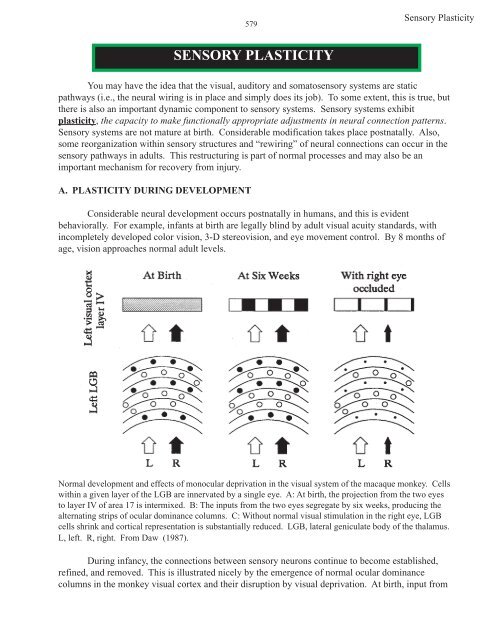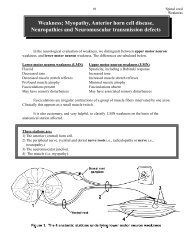SENSORY PLASTICITY
SENSORY PLASTICITY
SENSORY PLASTICITY
You also want an ePaper? Increase the reach of your titles
YUMPU automatically turns print PDFs into web optimized ePapers that Google loves.
579Sensory Plasticity<strong>SENSORY</strong> <strong>PLASTICITY</strong>You may have the idea that the visual, auditory and somatosensory systems are staticpathways (i.e., the neural wiring is in place and simply does its job). To some extent, this is true, butthere is also an important dynamic component to sensory systems. Sensory systems exhibitplasticity, the capacity to make functionally appropriate adjustments in neural connection patterns.Sensory systems are not mature at birth. Considerable modification takes place postnatally. Also,some reorganization within sensory structures and “rewiring” of neural connections can occur in thesensory pathways in adults. This restructuring is part of normal processes and may also be animportant mechanism for recovery from injury.A. <strong>PLASTICITY</strong> DURING DEVELOPMENTConsiderable neural development occurs postnatally in humans, and this is evidentbehaviorally. For example, infants at birth are legally blind by adult visual acuity standards, withincompletely developed color vision, 3-D stereovision, and eye movement control. By 8 months ofage, vision approaches normal adult levels.Normal development and effects of monocular deprivation in the visual system of the macaque monkey. Cellswithin a given layer of the LGB are innervated by a single eye. A: At birth, the projection from the two eyesto layer IV of area 17 is intermixed. B: The inputs from the two eyes segregate by six weeks, producing thealternating strips of ocular dominance columns. C: Without normal visual stimulation in the right eye, LGBcells shrink and cortical representation is substantially reduced. LGB, lateral geniculate body of the thalamus.L, left. R, right. From Daw (1987).During infancy, the connections between sensory neurons continue to become established,refined, and removed. This is illustrated nicely by the emergence of normal ocular dominancecolumns in the monkey visual cortex and their disruption by visual deprivation. At birth, input from
Sensory Plasticity580the two eyes is intermixed in layer 4 of visual cortex, the primary layer receiving LGB innervation.Normally, by six weeks, the input is segregated into alternating, equal-sized columns of input fromeach eye. These columns of alternating ocular dominance resemble those in the adult. However, ifthe input from one eye is significantly compromised (e.g., by a long period of occlusion), then thecortex becomes dominated by input from the “good” eye, and the representation in the cortex fromthe “deprived” eye is reduced. This has long-term perceptual consequences, as vision from thedeprived eye may remain poor, even if normal visual input is restored.This is a very clear example of how the sensory connections that become established areinfluenced by sensory experience. Sensory pathways that are well used firmly establish their neuralconnections within central sensory structures. In contrast, sensory pathways that are little or un-usedcan become weakened and lose representation in central sensory structures.Normal sensory experience is necessary for normal development. An important componentin the development of sensory systems is the concept of a sensitive or critical period. The criticalperiod is the time during development when neural connections are forming and the system is mostvulnerable to the damaging effects of abnormal sensory input. In the visual system, faulty visualinput, such as from a central cataract or strabismus, if not corrected before the end of the criticalperiod, can result in permanent visual deficits, including functional blindness. Once a child isbeyond the critical period, the visual deficit can remain permanent, even if the original source of theabnormal visual experience is corrected.Time course of the sensitive period for susceptibility to visual deprivation in humans.From Moses and Hart (1987).The critical period in visual development involves the first six years of life, although the firsttwo or three years are most crucial. The critical period in audition is less well defined, but appearsto last longer.
581Sensory PlasticityObviously, permanent compromise of sensory systems is not in an individual’s best interest.Sensory deprivation can severely impact not only the afferent sensory pathway itself, but othercognitive functions, as well. For example, in the auditory system of infants, discrimination ofspeech sounds begins within a few hours or days of birth, and much of the perceptual basis forspeech has been laid out by the 12th month after birth. Even a partial hearing loss during the earlyyears of life can seriously damage speech production and the acquisition of language.Thus, when sensory deficits are suspected, early intervention is critical to ensure the bestpossible outcome. It is valuable to recognize that vision and hearing assessments can be performedeven in very young children and infants.This is only meant to be a superficial introduction to the topic of neural plasticity duringdevelopment. (Don’t get bogged down in the experimental details of ocular dominance columns.)Focus on the fundamental concepts:• That is, the sensory systems are immature at birth.• The normal, postnatal development of our senseory systems depends on normal sensoryexperience.• Sensory deprivation or abnormal sensory experience during the critical period (in earlychildhood), if uncorrected, can lead to permanent deficits.B. <strong>PLASTICITY</strong> IN ADULTHOODUntil comparatively recently it was thought that once sensory nerve pathways wereestablished, no further restructuring could occur. However, it is now apparent that sensory neuralreorganization can take place in adults under a variety of circumstances.Reorganization After Peripheral LesionsSensory reorganization was first demonstrated in the adult somatosensory cortex followingperipheral nerve lesions. It was thought that such a lesion would result in a “silent zone” in thecorresponding region of somatosensory cortex, since those previously innervated cortical neuronswould be deprived of their somatosensory input. However, detailed somatotopic mapping of corticalareas before and after peripheral denervation shows that the “sensory deprived” neurons do notbecome silent. Instead, they become responsive to adjacent skin territories with intact peripheralinnervation. The cortical map shifts as adjacent subregions functionally take over and fill in thedenervated zone.
Sensory Plasticity582Plasticity in cerebral cortical area 3b (in S1) of an adult owl monkey. A: Normal somatotopic map of thedigits of the hand. B: Somatotopic map of the same region shown in part A, obtained two months after thethird digit was amputated. From Merzenich, et al. (1984).Although extensive reorganization has been observed to occur over several months, postdenervation, some of these changes can occur within minutes of the lesion. This plasticity has alsobeen reported in VPL, the dorsal column nuclei in the medulla and the dorsal horn in the spinal cord.Similar results are reported in the visual system.Reorganization After Central LesionsSensory plasticity in the adult has also been observed following lesion in the cerebral cortex.In this case, the peripheral innervation is intact, but the central nervous system target is not. Thecortical reorganization shifts so that the somatotopic location that was mapped originally onto thelesioned cortical region is now mapped adjacent to the lesion. These results suggest one mechanismfor recovery from stroke.Plasticity With LearningFinally, an expansion of a particular somatotopic area of the cerebral cortex is also observedin association with learning. For example, somatotopic reorganization was observed in adultmonkeys who were trained on a tactile discrimination task involving exclusively the use of aparticular digit. Following the training, the cortical representation of that digit had expandedsignificantly.Clearly, we must not think of the brain as a completely hard-wired series of connectionsbetween neurons. Instead, it is a structure that can adapt to the sensory environment and rearrangeto meet the needs of the body.










